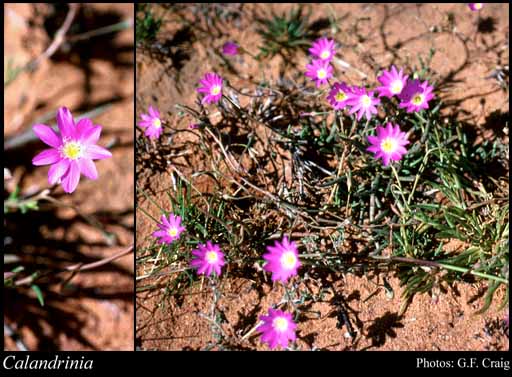- Reference
- Nov.Gen.Sp. Ed.Folio, 6(24):62 (1823)
- Name Status
- Current

Scientific Description
Common name. Parakeelyas. Family Portulacaceae.
Tribe Calandrineae, Calandrinia Section Pseudodianthoideae. The concept used here is the Australian species, which are likely in future to be recognised as the genus Rumicastrum.
Habit and leaf form. Herbs. ‘Normal’ plants. Leaves well developed. Plants with roots; succulent; unarmed. Annual, or perennial. Leaves basal, or cauline. Plants with a basal concentration of leaves; to 0.6 m high. Self supporting, or climbing; scrambling. Xerophytic. Not heterophyllous. Leaves alternate, or opposite (rarely); with blades; sessile, or petiolate (rarely); simple; not peltate. Leaf blades entire; flat, or solid; terete, or semi-terete (with a concave upper surface); linear to obovate. Mature leaf blades adaxially glabrous; abaxially glabrous. Leaves without stipules. Leaf blade margins entire. Leaf anatomy. Hairs absent.
Reproductive type, pollination. Fertile flowers hermaphrodite. Unisexual flowers absent. Plants hermaphrodite.
Inflorescence and flower features. Flowers aggregated in ‘inflorescences’. Inflorescence few-flowered, or many-flowered. Flowers in cymes. Inflorescences compound. The terminal inflorescence unit cymose. Flowers pedicellate; bracteate; small; regular; cyclic; tetracyclic. Perianth with distinct calyx and corolla; 2–11; 2 -whorled; anisomerous. Calyx present; 2; 1 -whorled; polysepalous; persistent, or not persistent. Corolla present; (4–)5(–11); 1 -whorled; polypetalous; white, or pink, or purple. Petals obovate, or elliptic. Androecium present. Androecium 3–100 (‘numerous’). Androecial members free of one another. Androecium exclusively of fertile stamens. Stamens 3–100 (‘numerous’); all more or less similar in shape. Anthers separate from one another; all alike; dehiscing via longitudinal slits; bilocular. Gynoecium 2–9 carpelled. The pistil 1 celled. Gynoecium syncarpous; synovarious to synstylovarious; superior. Ovary unilocular; 1 locular. Gynoecium stylate. Styles 3, or 4; free, or partially joined; simple. Placentation basal, or free central (at maturity). Ovules in the single cavity 1–50 (‘numerous’).
Fruit and seed features. Fruit 1.5–9 mm long; light brown, or black (rarely); dehiscent; a capsule. Capsules valvular. Dispersal unit the seed. Fruit 1–50 seeded (‘numerous’). Seeds minute, or small.
Geography, cytology, number of species. World distribution: cosmopolitan. Native of Australia, or adventive. Endemic to Australia, or not endemic to Australia. Australian states and territories: Western Australia, South Australia, New South Wales, Victoria, and Tasmania. South-West Botanical Province. A genus of ca 120 species; 29 species in Western Australia; ca 2 endemic to Western Australia.
Etymology. After Jean Luis Calandrini (1703–58), professor of mathematics and botany at Geneva.